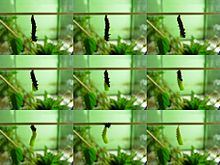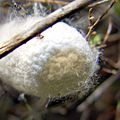Doll (butterfly)


In zoology, a pupa refers to the insect larva in the last stage of development on the way to becoming a fully mature insect (see also: pupa (insect) ), which is usually in a completely rest position . In the case of butterflies , the pupa is either surrounded by a thin shell, the pupal skin, or by a web or cocoon spun by the caterpillar itself .
Doll shapes
In the butterfly families grouped under butterflies, two types of pupae are distinguished according to the type of attachment to the base: tumble pupae and girdle pupae . In the former, the dolls, surrounded by a thin doll shell, hang freely dangling with hooks from a web anchoring that is attached to the base. In the case of the belt dolls, like the fall dolls, the doll is surrounded by a thin doll shell and attached to a base, but is also connected to a twig or the like by a thread that is spun around the middle of the body like a belt. These dolls usually do not hang down, but are attached to the top or to the side by the spun thread.
The pupae of the remaining butterfly families pupate either freely on the ground or in a more or less tightly spun silk web. This is called a cocoon . The silk is made from special spinning glands located on the lower lip. Precautions are necessary so that the finished butterfly can leave its sometimes very solid pupa. Either a round lid is provided, which is then pushed open from the inside, or a trap allows the butterfly to crawl out without uninvited guests being able to penetrate through it. This is e.g. B. the case with the lesser night peacock butterfly ( Saturnia pavonia ). Other species secrete a liquid from the mouth opening that softens the cocoon.
The forms mentioned above occur in the moths , but the form with a cocoon is relatively common. Dolls without a cocoon do not hang above the ground, but rest in the ground .
Pupation
When the caterpillar is an adult, it begins to pupate by shedding its skin for the last time. Then the metamorphosis to the butterfly takes place. The caterpillar organs are broken down or reshaped and transformed into butterfly organs and the entire external shape of the animals changes. The pupae of the butterflies are basically mummy pupae. This means that all body attachments (antennae, leg systems and wing sheaths) are glued to the body with a putty. Only the primeval moths (Micropterigidae) have free pupae in which the limbs are not glued together. The three body sections of the mummy dolls are difficult to recognize, but the appendages and the head are clearly visible.
The doll phase (so-called doll rest) is usually two to four weeks. However, some species overwinter as a pupa. Here the moths develop before winter, but only hatch in spring. Sometimes the moths rest in the pupae for longer than one winter. So z. B. the spring wool juices ( Eriogaster lanestris ) remain in their pupae for up to seven years before they hatch.
Camouflage and hatching
In many species (especially butterflies) the pupae do not have a protective web or cocoon , but only a pupa skin. They are therefore very sensitive and must have good camouflage . You cannot - as with pupae in the ground ( moths ) or species with thick webs - trust that predators will let go of their attack because of the tough and difficult-to-penetrate outer skin. Such pupae are often perfectly camouflaged, like fresh or dried leaves. Some can even make chirping noises to confuse attackers.
The doll is almost immobile. She can only swing her abdomen sideways and make rolling movements. Some (e.g. glass winged birds (Sesiidae) and wood drills (Cossidae)) have thorns on the abdominal segments, with which they can work their way through their feeding ducts in the wood towards the opening in order to get to the outside more easily after hatching. In the more primitive families, however, the appendages of the body can also be moved easily.
Falling doll of the little fox
upward girdle of the tree whitefly ; After about the first third the thin belt thread can be seen
literature
- Hans Piepho and Alfred Kühn : About hormonal effects in the pupation of butterflies. Göttingen 1936
- Hans Piepho: Investigations on the developmental physiology of the insect metamorphosis . About the doll skinning of the wax moth Galleria mellonella L. Berlin 1942
Individual evidence
- ↑ C. Guggisberg, E. Hunzinger: Butterflies and moths . P. 25 f., Hallwag, Bern ~ 1960.


